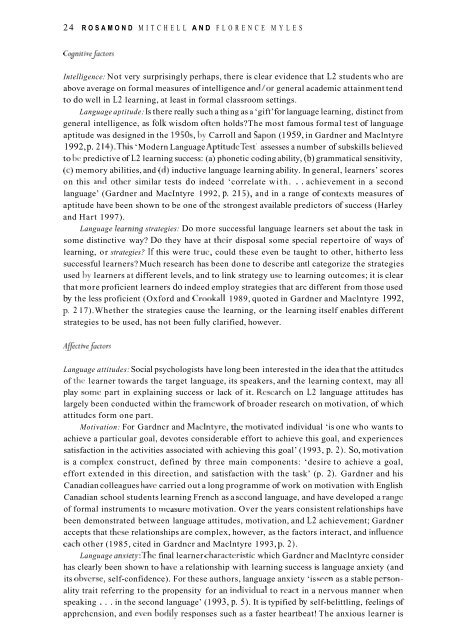English Language Teaching in its Social Context
English Language Teaching in its Social Context
English Language Teaching in its Social Context
You also want an ePaper? Increase the reach of your titles
YUMPU automatically turns print PDFs into web optimized ePapers that Google loves.
24 ROSAMOND MITCHELL AND FLORENCE M Y L E SCognjtivefactorsIntelligence: Not very surpris<strong>in</strong>gly perhaps, there is clear evidence that L2 students who areabove average on formal measures of <strong>in</strong>telligence and/or general academic atta<strong>in</strong>ment tendto do well <strong>in</strong> L2 learn<strong>in</strong>g, at least <strong>in</strong> formal classroom sett<strong>in</strong>gs.<strong>Language</strong> aptitude: Is there really such a th<strong>in</strong>g as a ‘gift’ for language learn<strong>in</strong>g, dist<strong>in</strong>ct fromgeneral <strong>in</strong>telligence, as folk wisdom often holds? The most famous formal test of languageaptitude was designed <strong>in</strong> the 1950s, by Carroll and Sapon (1 959, <strong>in</strong> Gardner and Maclntyre1992, p. 2 14).This ‘Modern <strong>Language</strong> AptitudcTest’ assesses a number of subskills believedto be predictive of L2 learn<strong>in</strong>g success: (a) phonetic cod<strong>in</strong>g ability, (b) grammatical sensitivity,(c) memory abilities, and (d) <strong>in</strong>ductive language learn<strong>in</strong>g ability. In general, learners’ scoreson this antl other similar tests do <strong>in</strong>deed ‘correlate with. . . achievement <strong>in</strong> a secondlanguage’ (Gardner and MacIntyre 1992, p. 2 15), and <strong>in</strong> a range of contexts measures ofaptitude have been shown to be one of the strongest available predictors of success (Harleyand Hart 1997).<strong>Language</strong> Iearn<strong>in</strong>g strategies: Do more successful language learners set about the task <strong>in</strong>some dist<strong>in</strong>ctive way? Do they have at their disposal some special repertoire of ways oflearn<strong>in</strong>g, or strategies? If this were truc, could these even be taught to other, hitherto lesssuccessful learners? Much research has been done to describe antl categorize the strategiesused by learners at different levels, and to l<strong>in</strong>k strategy use to learn<strong>in</strong>g outcomes; it is clearthat more proficient learners do <strong>in</strong>deed employ strategies that arc different from those usedby the less proficient (Oxford and Crookall 1989, quoted <strong>in</strong> Gardner and Maclntyre 1992,p. 2 17). Whether the strategies cause the learn<strong>in</strong>g, or the learn<strong>in</strong>g <strong>its</strong>elf enables differentstrategies to be used, has not been fully clarified, however.Afecti vefactors<strong>Language</strong> attitudes: <strong>Social</strong> psychologists have long been <strong>in</strong>terested <strong>in</strong> the idea that the attitudcsof the learner towards the target language, <strong>its</strong> speakers, antl the learn<strong>in</strong>g context, may allplay some part <strong>in</strong> expla<strong>in</strong><strong>in</strong>g success or lack of it. Research on L2 language attitudes haslargely been conducted with<strong>in</strong> the framcwork of broader research on motivation, of whichattitudcs form one part.Motivation: For Gardncr and MacIntyrc, the motivated <strong>in</strong>dividual ‘is one who wants toachieve a particular goal, devotes considerable effort to achieve this goal, and experiencessatisfaction <strong>in</strong> the activities associated with achiev<strong>in</strong>g this goal’ (1993, p. 2). So, motivationis a complex construct, def<strong>in</strong>ed by three ma<strong>in</strong> components: ‘desire to achieve a goal,effort extended <strong>in</strong> this direction, and satisfaction with the task’ (p. 2). Gardner and hisCanadian colleagues have carried out a long programme of work on motivation with <strong>English</strong>Canadian school students learn<strong>in</strong>g French as a sccond language, and have developed a rangeof formal <strong>in</strong>struments to measure motivation. Over the years consistent relationships havebeen demonstrated between language attitudes, motivation, and L2 achievement; Gardneraccepts that these relationships are complex, however, as the factors <strong>in</strong>teract, and <strong>in</strong>fluenceeach other (1 985, cited <strong>in</strong> Gardncr and Maclntyre 1993, p. 2).<strong>Language</strong> anxiety:Thc f<strong>in</strong>al learner charactcristic which Gardncr and Maclntyrc considerhas clearly been shown to have a relationship with learn<strong>in</strong>g success is language anxiety (and<strong>its</strong> obvcrse, self-confidence). For these authors, language anxiety ‘is seen as a stable pcrsonalitytrait referr<strong>in</strong>g to the propensity for an <strong>in</strong>dividual to react <strong>in</strong> a nervous manner whenspeak<strong>in</strong>g . . . <strong>in</strong> the second language’ (1 993, p. 5). It is typified by self-belittl<strong>in</strong>g, feel<strong>in</strong>gs ofapprchcnsion, and even bodily responses such as a faster heartbeat! The anxious learner is












